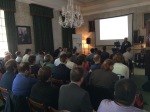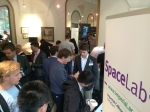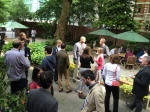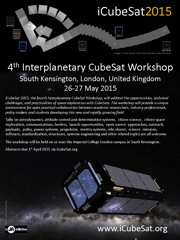iCubeSat Program 2015



iCubeSat 2015 was held over two days at Imperial College London, United Kingdom. Please note that this conference was an open conference and did not wish to discuss information restricted by ITAR or other export controls. U.S. citizens and permanent residents were responsible for ensuring that technical data presented was not restricted by ITAR and that ITAR controlled information was not discussed with non-U.S. citizens. All conference attendees ensured that their presentations and discussions complied with the relevant export controls of their own country, the United Kingdom and the European Union and those using the comments facility of the website are reminded that they should do the same.

Download the conference poster here.
Tuesday, 26th May 2015
| 09:30 |
Registration |
|
|
|
|
| 10:00 |
|
Welcome
Michael Johnson, JA / PocketSpacecraft.com
Steven Schwartz, Director, Imperial Space Lab |
| 10:15 |
|
A.1.1. Achieving Science Goals with CubeSats: an National Research Council Study
Thomas H. Zurbuchen, University of Michigan, USA |
| 10:30 |
|
A.1.2. NanoSWARM: a big CubeSat mission
Jordi Puig-Suari, Tyvak Nano-Satellite Systems, USA |
| 10:45 |
|
A.1.3. A CubeSat Microgravity Experiment on Collisions in the Protoplanetary Disk
Joshua Colwell, University of Central Florida, USA
|
| 11:00 |
|
A.1.4. An L1 CubeSat monitor for space weather
Markos Trichas, Airbus Defence and Space, UK |
| 11:15 |
|
A.1.5. Centaur: A scientific and technology pathfinder for direct imaging exoplanet missions
Eduardo Bendek, NASA Ames, USA |
| 11:30 |
Break |
|
| 12:00 |
|
A.2.1. CubeSat Landing Opportunities for Binary Asteroid Exploration
Onur Celik, Cranfield University, UK |
| 12:15 |
|
A.2.2. CuSPP+: an interplanetary CubeSat to study particle acceleration
Eric Christian, NASA GSFC, USA |
| 12:30 |
|
A.2.3 A CubeSat for UV Astrophysics
Richard Desselle, Centre Spatial de Liège, Belgium |
| 12:45 |
|
A.2.4. PIXE 2015: PocketSpacecraft.com Integrated eXploration Environment update
Michael Johnson, PocketSpacecraft.com, UK |
| 13:00 |
Lunch |
|
| 14:30 |
|
A.3.1. Enhanced electromagnetic sounding of Europa’s ocean using CubeSats
Frank Crary, University of Colorado, USA
|
| 14:45 |
|
A.3.2. ICE-CUBE for ILSRA 2014
Elke Rabbow, DLR, Germany
|
| 15:00 |
|
A.3.3. SERB, a nano-satellite dedicated to Sun-Earth relationship
Mustapha Meftah, CNRS-LATMOS, France
|
| 15:15 |
|
A.3.4. SSWARMS: Solar Storm Warning And Radiation Monitoring System
William Edmonson, NC A&T State University, USA
|
| 15:30 |
|
A.3.5. Using CubeSats to survey asteroids as part of an asteroid mining mission
Kieran Hayward, Cranfield University, UK
|
| 15:45 |
|
A.3.6 Mothership – Affordable Exploration of Planetary Bodies through Individual Nano-Sats and Swarms
Sebastian Ernst, Deep Space Industries, USA
|
| 16:00 |
Break |
|
| 16:30 |
|
A.4.1. CubeSat-based research for planetary missions at UNSW Canberra
Russell Boyce, UNSW Canberra, Australia
|
| 16:45 |
|
A.4.2. A CubeSat Development Programme For Planetary Science, Space Weather and Maritime Situational Awareness
Nigel Bannister, University of Leicester, UK
|
| 17:00 |
|
A.4.3. Creating Facilities, Tools, and Services for Scientific Collaboration
Brenda Dingwall, NASA WFF, USA
|
| 17:15 |
|
A.4.4. On the suitability of CubeSats on Earth orbits for radiation testing of interplanetary payloads
Friederike Wolff, Luleå University of Technology, Sweden
|
| 17:30 |
|
A.4.5. J³: CubeSats as a Platform for In-Orbit Verification of Scientific Instruments for Interplanetary Missions
Jonas Burgdorf, Luleå University of Technology, Sweden
|
|
|
|
19:00
-21:00 |
Social |
Informal dinner in central London
(Please note that the cost of the dinner is not included in the registration fee) |
Wednesday, 27th May 2015
| 09:00 |
Registration |
|
| 09:45 |
|
B.1.1. Cost-Effective, Frequent, Reliable CubeSat Access to GTO/GEO
Alfred Tadros, Space Systems Loral, USA |
| 10:00 |
|
B.1.2. Interplanetary CubeSat Launch Opportunities and Payload Accommodations
Roland Coelho, Tyvak Nano-Satellite Systems, USA
|
| 10:15 |
|
B.1.3. Science by Cubes: opportunities to increase AIM scientific return
Ian Carnelli, European Space Agency, France |
| 10:30 |
|
B.1.4. Lunar orbit stability for small satellite mission design
Andres Dono, NASA Ames, USA |
| 10:45 |
|
B.1.5. Uncertainty-based Multidisciplinary Design Optimization of Lunar CubeSat Missions
Xingzhi Hu, National University of Defense Technology, China |
| 11:00 |
Break |
|
| 11:30 |
|
B.2.1. Inter-CubeSat Communications: Routing Between CubeSat Swarms in a DTN Architecture
Mohamed Madni, University of Wollongong, Australia |
| 11:45 |
|
B.2.2. Low Profile Aperture Coupled Microstrip Antenna for Inter CubeSat Communications
Faisel Tubbal, University of Wollongong, Australia
|
| 12:00 |
|
B.2.3. Low-Profile Antenna Package for Efficient InterCubeSat Communication in S- and V-band
Clement Vourch, University of Glasgow, UK |
| 12:15 |
|
B.2.4. A “nano” rotary compressor with a 1:12 compression ratio for CubeSats
Olly Dmitriev, VERT Rotors, UK |
| 12:30 |
|
B.2.5. Application of multiple system on a chip technology systems in micro-nano satellite integrated electronic systems
Lidong Ian, Nanjing University of Aeronautics and Astronautics, China |
| 13:00 |
Lunch |
|
| 14:30 |
|
B.3.1. Design and Implementation of Triple Modular Redundant System on Linux-Based On-Board Computer for CubeSat
Emir Husni, Bandung Institute of Technology, Indonesia |
| 14:45 |
|
B.3.2. Performance of a smartphone based star tracker
Andrey Khorev, University of Montpellier, France |
| 15:00 |
|
B.3.3. PocketRTG – a CubeSat scale radioisotope thermoelectric generator using COTS fuel
Lucy Berthoud, University of Bristol, UK |
| 15:15 |
|
B.3.4. Small-Scale Radioisotope Thermoelectric Generator and Heater Units Based on Americium-241
Richard Ambrosi, University of Leicester, UK |
| 15:30 |
|
B.3.5. SurfSat – Surface charging and ESD measurements on a CubeSat
Adrienne Dove, University of Central Florida, USA |
| 15:45 |
|
B.3.6. The Development of a Low Mass Extendible Composite Boom for Small Satellite Applications
Mike Lawton, Oxford Space Systems, UK |
| 16:00 |
Break |
|
| 16:30 |
|
B.4.1. Cathode-less gridded ion thrusters for small satellites
Ane Aanesland, CNRS-Ecole Polytechnique, France |
| 16:45 |
|
B.4.2. Deployment Technology of a Heliogyro Solar Sail for Long Duration Propulsion
Peerawan Wiwattananon, National Institute of Aerospace, USA |
| 17:00 |
|
B.4.3. Early Stage Development of Dynamic Simulation Platform For Reaction Wheels Controlled CubeSat Model
Ryan Fadhilah Hadi, Bandung Institute of Technology, Indonesia |
| 17:15 |
|
B.4.4. LightSail: Solar Sailing With a 3U CubeSat
Rex Ridenoure, Ecliptic Enterprises, USA |
| 17:30 |
|
B.4.5. NRC Interplanetary CubeSat Roundtable
Group discussion |
|
|
|
| 18:00 |
Close |
|
Posters
Please do not hesitate to contact committee@iCubeSat.org if you have any comments or questions.



